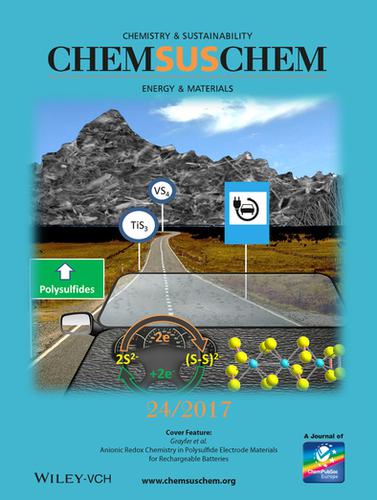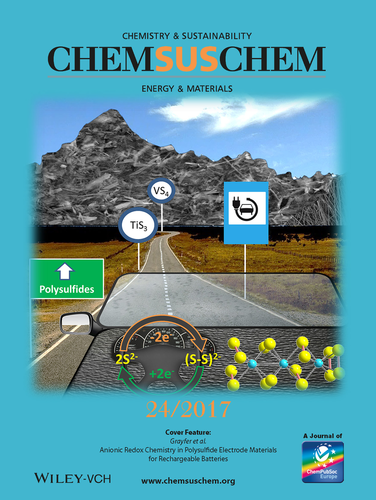当前位置:
X-MOL 学术
›
ChemSusChem
›
论文详情
Our official English website, www.x-mol.net, welcomes your feedback! (Note: you will need to create a separate account there.)
Cover Feature: Anionic Redox Chemistry in Polysulfide Electrode Materials for Rechargeable Batteries (ChemSusChem 24/2017)
ChemSusChem ( IF 8.4 ) Pub Date : 2017-12-13 , DOI: 10.1002/cssc.201702310 Ekaterina D. Grayfer 1 , Egor M. Pazhetnov 1 , Mariia N. Kozlova 1 , Sofya B. Artemkina 1 , Vladimir E. Fedorov 1, 2
ChemSusChem ( IF 8.4 ) Pub Date : 2017-12-13 , DOI: 10.1002/cssc.201702310 Ekaterina D. Grayfer 1 , Egor M. Pazhetnov 1 , Mariia N. Kozlova 1 , Sofya B. Artemkina 1 , Vladimir E. Fedorov 1, 2
Affiliation

|
The Cover Feature shows a representation of a future electric vehicle powered by Li‐ion batteries with transition‐metal polysulfide electrodes driven on a road. Polysulfide electrodes have an unusual operation mechanism featuring anionic redox processes in disulfide groups (S−S)2−. The main redox reaction is schematically drawn on the hand wheel. As an example, a fragment of the VS4 structure is displayed on the control panel. The yellow balls are S atoms connected in pairs and the blue balls are V atoms. The mountains at the backdrop are “filled” with fragments of TaS3 and NbS3 microstructures symbolizing the vast opportunities that the rich polysulfide family offers for energy conversion and storage. More information can be found in the Concept by Grayfer et al. on page 4805 in Issue 24, 2017 (DOI: 10.1002/cssc.201701709).

中文翻译:

封面功能:可充电电池的多硫化物电极材料中的阴离子氧化还原化学(ChemSusChem 24/2017)
封面功能展示了未来用锂离子电池驱动的电动汽车的示意图,该电动汽车具有在道路上行驶的过渡金属多硫化物电极。多硫化物电极具有不寻常的工作机制,其特征在于二硫化物基团(SS)2-中的阴离子氧化还原过程。主要的氧化还原反应示意性地绘制在手轮上。例如,VS 4结构的片段显示在控制面板上。黄色的球是成对连接的S原子,蓝色的球是V原子。背景中的山脉被TaS 3和NbS 3的碎片“填充”微观结构象征着丰富的多硫化物家族为能量转换和存储提供的巨大机会。可以在Grayfer等人的Concept中找到更多信息。就在第24期,2017年4805页(:10.1002 / cssc.201701709 DOI)。

更新日期:2017-12-13

中文翻译:

封面功能:可充电电池的多硫化物电极材料中的阴离子氧化还原化学(ChemSusChem 24/2017)
封面功能展示了未来用锂离子电池驱动的电动汽车的示意图,该电动汽车具有在道路上行驶的过渡金属多硫化物电极。多硫化物电极具有不寻常的工作机制,其特征在于二硫化物基团(SS)2-中的阴离子氧化还原过程。主要的氧化还原反应示意性地绘制在手轮上。例如,VS 4结构的片段显示在控制面板上。黄色的球是成对连接的S原子,蓝色的球是V原子。背景中的山脉被TaS 3和NbS 3的碎片“填充”微观结构象征着丰富的多硫化物家族为能量转换和存储提供的巨大机会。可以在Grayfer等人的Concept中找到更多信息。就在第24期,2017年4805页(:10.1002 / cssc.201701709 DOI)。



























 京公网安备 11010802027423号
京公网安备 11010802027423号